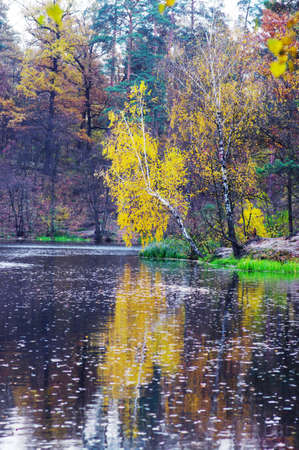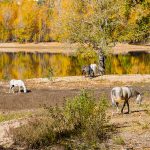Understanding Fall Bass Behavior
As summer fades and autumn sets in, bass behavior starts to shift in noticeable ways. Understanding these changes is the first step toward choosing the right baits and lures for the season. Cooler water temperatures, shorter daylight hours, and the migration of baitfish all play a major role in how bass feed during the fall months.
Why Bass Behavior Changes in Fall
Bass are cold-blooded creatures, which means their activity levels are directly influenced by water temperature. As lakes and rivers cool down in the fall, bass become more active compared to the sluggish movements they show during hot summer days. This increased activity is also driven by their need to bulk up before winter, when food becomes scarce and their metabolism slows down.
Key Environmental Triggers
| Factor | Effect on Bass |
|---|---|
| Cooler Water Temps | Boosts bass activity and encourages feeding frenzies |
| Shorter Days | Signals seasonal change, triggering instinctual feeding patterns |
| Baitfish Migration | Bass follow schools of shad or minnows into shallower areas |
Baitfish Movement: The Main Driver
One of the most important things to note about fall fishing is the movement of baitfish like shad and minnows. These smaller fish begin moving from deeper waters into shallow coves and creeks as water temperatures drop. Bass will naturally follow them, often ambushing them in these tighter spaces. Matching your bait or lure to what these baitfish look like can dramatically increase your chances of a strike.
Where to Find Fall Bass
- Shallow coves and creek arms
- Points leading into bays or backwaters
- Drop-offs near schools of baitfish
By knowing where bass are likely to be and why they’re there, you’ll be better equipped to choose baits that mimic their natural prey. That’s what we’ll explore next—how to pick the best baits and lures for fall bass fishing based on this behavior shift.
2. Top Live Baits for Fall Bass Fishing
When fall rolls around, bass begin to feed aggressively in preparation for winter. This seasonal transition makes live bait an excellent choice, especially when youre trying to mimic the natural forage that bass are keying in on. Here are some of the most effective live baits you can use to catch more bass during autumn.
Why Live Bait Works in the Fall
As water temperatures drop, baitfish like shad and minnows become more active and move into shallower waters. Bass follow them closely, making this a prime opportunity for anglers using live bait. Live baits offer realistic movement, scent, and appearance that artificial lures cant always match—especially when bass are being picky.
Best Live Baits for Fall Bass
| Live Bait | Why It Works | How to Rig It |
|---|---|---|
| Shiners | Resemble baitfish like shad; very active in cooler water | Lip-hooked on a circle hook with a bobber or free-lined |
| Minnows | Mimic natural prey; easy to find at local bait shops | Nose-hooked or tail-hooked for natural swimming action |
| Nightcrawlers | Release scent and wiggle naturally; great for finesse bites | Threaded onto a hook or wacky-rigged with split shot weight |
Shiners: A Go-To Choice for Aggressive Fall Bass
Shiners are one of the top picks during fall because they closely resemble young-of-the-year shad, which are a main food source for bass. Their flashy movement and size make them irresistible when bass are hunting in packs. Fish them near weed lines, docks, or shallow flats where bass are chasing schools of baitfish.
Minnows: Easy, Effective, and Readily Available
If you’re looking for convenience and effectiveness, minnows are hard to beat. They’re widely available at most tackle shops and work well whether you’re fishing from shore or a boat. Use light tackle and let the minnow swim freely to trigger strikes from both largemouth and smallmouth bass.
Nightcrawlers: The Classic Option That Still Delivers
Although often associated with panfish or catfish, nightcrawlers are surprisingly effective for catching finicky fall bass. Their natural scent and squirming motion can entice even lethargic fish into biting. Try using them after a cold front or during slower bite windows when other baits aren’t producing.

3. Best Artificial Lures for Autumn
As the weather cools and bass start feeding more aggressively to prepare for winter, artificial lures become a top choice for many anglers. In fall, bass are often chasing baitfish in shallower waters, making it a perfect time to use fast-moving and reaction-style lures. Here’s a breakdown of some of the most effective artificial lures for autumn bass fishing and tips on how to fish them based on water clarity and conditions.
Crankbaits
Crankbaits are ideal in fall because they mimic the movement of baitfish and can cover a lot of water quickly. Use shallow- or medium-diving crankbaits in shad or craw colors depending on your local forage base.
How to Use:
- Clear Water: Choose natural colors like silver, white, or translucent patterns. Retrieve at a steady pace along points or drop-offs.
- Muddy Water: Opt for brighter colors like chartreuse or orange. Use a stop-and-go retrieve to trigger reaction strikes.
Spinnerbaits
Spinnerbaits are great for covering water and finding active fish. Their flash and vibration make them especially effective in stained or murky waters where visibility is low.
How to Use:
- Clear Water: Go with double willow blades and natural-colored skirts. Slow-roll it around weed edges and submerged timber.
- Muddy Water: Use Colorado blades for more thump and vibration, paired with bright skirts. Retrieve steadily through heavy cover.
Jerkbaits
Suspending jerkbaits shine when bass are keyed in on baitfish near points, flats, or the mouths of creeks. They work especially well as water temps drop into the 50s.
How to Use:
- Clear Water: Use natural finishes like ghost minnow or clear shad. Employ a twitch-twitch-pause cadence, varying your pauses until you find what triggers bites.
- Muddy Water: Use louder color patterns like clown or firetiger. Add longer pauses between jerks to give fish time to locate the lure.
Lure Selection Guide Based on Conditions
| Water Clarity | Lure Type | Recommended Colors | Retrieve Tips |
|---|---|---|---|
| Clear | Crankbait, Jerkbait, Spinnerbait (Willow) | Natural (shad, silver, ghost) | Steady or twitch retrieve with subtle movement |
| Muddy/Stained | Crankbait, Spinnerbait (Colorado), Jerkbait | Bright (chartreuse, firetiger) | Aggressive retrieve with pauses to increase visibility |
Selecting the right artificial lure during autumn depends on reading the conditions and adjusting your presentation accordingly. With these proven baits in your tackle box, youre better equipped to stay on the bite all season long.
4. Fall Bass Fishing Techniques and Tips
As the temperatures drop and bass start feeding heavily to prepare for winter, using the right techniques can make all the difference in your success on the water. Pairing the best fall baits and lures with effective presentation and retrieval methods is key to triggering aggressive strikes.
Match Your Retrieval Speed to Water Temperature
During early fall when water temps are still relatively warm, bass tend to be more active and willing to chase faster-moving baits. As the season progresses and water cools, slowing down your retrieve becomes more important. Heres a simple guide:
| Water Temperature (°F) | Recommended Retrieve Speed |
|---|---|
| 65° and above | Moderate to Fast |
| 55°–65° | Moderate |
| Below 55° | Slow and Steady |
Use Strategic Casting Angles
Casting angles can help you cover more water and present your lure naturally. Try casting parallel to drop-offs or along weed lines where bass are likely to ambush prey. When fishing around structure like docks, stumps, or submerged rocks, cast slightly past the target and retrieve past it to keep your bait in the strike zone longer.
Target Key Fall Structures
Bass transition from deeper summer haunts to shallower feeding areas during fall. Focus your efforts on these high-percentage spots:
- Main Lake Points: Great ambush zones as bass move between deep and shallow water.
- Baitfish Schools: Use electronics to locate shad or other forage fish—bass won’t be far behind.
- Docks and Laydowns: Provide shade and cover for bass staging near shorelines.
- Rocky Banks: Retain heat longer and attract baitfish as temperatures drop.
Presentation Tips by Lure Type
| Lure Type | Presentation Tip |
|---|---|
| Craw-style Soft Plastics | Drag slowly along bottom near rocks or wood; mimic natural crawfish movement. |
| Lipless Crankbaits | Use a yo-yo retrieve over grass flats or drop-offs; triggers reaction bites. |
| Suspending Jerkbaits | Twitch-pause-twitch method near points and bluff walls; imitate injured baitfish. |
| Spinnerbaits/Chatterbaits | Straight retrieve through shallow cover; vary speed until you get a strike. |
| Topwater (early fall) | Walk-the-dog or pop-and-stop over submerged vegetation during low light hours. |
Adjust Based on Conditions
Windy Days:
Bass often move up and feed aggressively in wind-blown areas. Use moving baits like spinnerbaits or squarebill crankbaits that create vibration in stained water.
Calm & Sunny Days:
Bass may tuck into cover or suspend off structure. Try finesse tactics like dropshots or slow-rolled swimbaits with natural colors.
Dialing in these techniques with the right baits will greatly improve your odds of landing quality bass this fall. Keep experimenting until you find what works best for the day’s conditions!
5. Weather and Water Conditions to Watch
When youre bass fishing in the fall, one of the biggest game-changers is the weather. As temperatures start to drop and daylight shortens, both weather patterns and water conditions shift—and bass behavior follows suit. Understanding how these changes affect bass can help you choose the right bait or lure and adjust your tactics for better results.
Cold Fronts: What They Mean for Bass
Cold fronts are common during autumn and they can have a big impact on your fishing trip. When a cold front rolls through, it usually brings a sudden drop in air temperature and often high pressure behind it. This causes bass to become less active and retreat to deeper or more sheltered areas. You might notice that bass feeding slows down dramatically for a day or two after a strong front.
How to Adjust:
- Fish slower and with finesse-style baits like soft plastics or jigs.
- Target deeper structure such as ledges, rock piles, or submerged timber.
- Use natural colors that blend into the environment for a more subtle presentation.
Water Temperature Shifts
Bass are cold-blooded, so their activity level is closely tied to water temperature. In early fall, water temps are still relatively warm, which means bass are more aggressive and willing to chase moving lures like crankbaits or spinnerbaits. But as the season progresses and temps drop into the 50s (°F), bass slow down and change locations.
| Water Temperature (°F) | Bass Behavior | Recommended Lures |
|---|---|---|
| 65–75 | Active, chasing baitfish | Lipless crankbaits, spinnerbaits |
| 55–65 | Transition phase; schooling near points or coves | Jerkbaits, medium-diving crankbaits |
| Below 55 | Sluggish, holding deep | Jigs, soft plastics, blade baits |
Wind and Cloud Cover
A little wind can actually be your friend when bass fishing in autumn. Wind stirs up the water, breaks up light penetration, and pushes baitfish toward shorelines—where bass will follow. Overcast days with some wind often lead to better topwater or reaction bite opportunities.
Tactical Tips:
- On windy days, try fast-moving baits like chatterbaits along windblown banks.
- If its overcast, topwater lures like walking baits can trigger explosive strikes even in cooler temps.
By paying attention to these fall weather patterns and water conditions, you can make smarter decisions on where to fish and what to throw. Bass may be on the move this time of year, but with the right approach, you’ll stay one step ahead of them.


